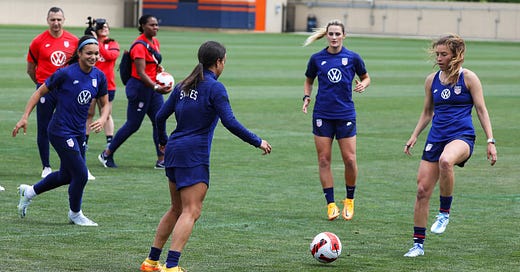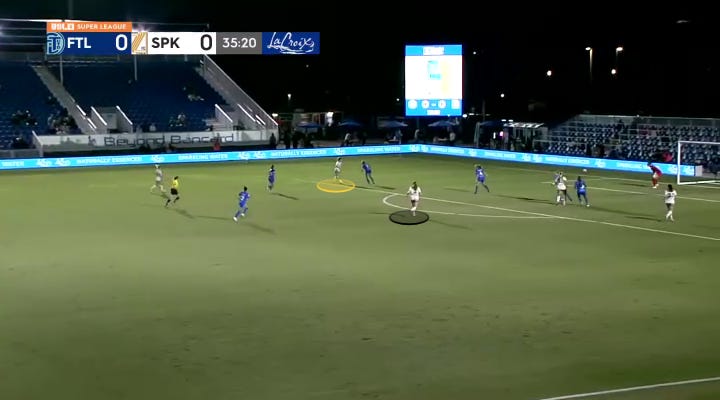How Do We Develop Players That Play A Collective Game?
Some thoughts and feelings about a particular aspect of player and team development.
Whenever I watch women’s and girls’ football here in the United States, I often have the feeling that something is missing.
After some reflection, I have come to realize that it is because girls in the US play individually in a collective game. This means that most of the thoughts, decisions, and actions are carried out based on what the individual player sees and wants for herself in that moment.
In an attempt to explain my thoughts, I have zoomed in on a specific moment in possession: the relationship between wide players positioned in the wide channel and and midfielders positioned in the half space on the same side.
I have provided a graphic of the channels on the field below:
“If You Want To Go Fast, Go Alone; If You Want To Go Far, Go Together”
A few months ago, I wrote a profile on Emma Jaskaniec of the Spokane Zephyr. My main motivation behind the report was to highlight her movement off of the ball in possession.
I noticed that even though she had good movement off of the ball, sometimes her teammates did not pass her the ball despite the spaces she was able to put herself in.
In the image below, Spokane Forward Emina Ekic was on the ball in the left wide channel in the attacking third. She can be seen with the yellow circle, and Jaskaniec’s positioning can be seen with the black circle.
In this sequence, Ekic delayed her actions and tried to take on her defender 1v1. This allowed the Ft. Lauderdale players to retreat and made what was a possible 2v1 situation a 2v3 situation.
Self awareness is vital for players. A player that truly understands and accepts her strengths and weaknesses is in a place to leverage her strengths and cover her weaknesses.
Ekic did not beat Ft. Lauderdale’s right back for pace or skill during this game. This in fact, was the second moment where she found herself in a wide area in the attacking third in a very similar situation.
Had Ekic been real about the situation she was in, she would have used her teammates to put herself in a more advantageous position. Utilizing the 2v1 and lending the ball to Jaskaniec while she moves in order to get the ball back.
While that line of thought is still technically making decisions based on the individual, it involves a partner which makes it social.
“The Eyes Chico, They Never Lie”
Later in the same game, Spokane Left Back Haley Thomas had a throw in in the left wide channel in the attacking third.
Below, Thomas had received the ball back after completing the throw. She can be seen with the yellow circle, and Jaskaniec is highlighted in the black circle.
Before taking the throw in, during the throw in, after throwing the ball in, and after receiving the ball back, Thomas never scanned beyond the immediate wide channel she was positioned in.
Due to her lack of scanning, Thomas attempted to force a pass forward within the same wide channel which ultimately ended out of play.
It is well established that scanning is important. At any youth training session in the United States directions to scan can be heard.
But how do we get players to see instead of just looking? What are they supposed to be looking for?
Once they see, can we push them to a place where the eyes do in fact lie? Where the use of body orientation, head angle, and eyeline are used to move the opposition and create space for teammates and self.
“Make The Extra Pass”
The game is an obsession for 90 minutes. If you go left, does she go left? What do they do if we move the ball here? It’s constant adjustment and reading.
The frame below is from the 2025 ECNL National Playoffs that took place in San Diego.
The center back on the ball is circled in yellow. The midfielder dropping down to present as an option is circled in black.
As the midfielder presented herself as an option, her mark dropped down with her.
In frame #2, the midfielder in possession began her dismarking movement between lines against the momentum of her mark.
In frame 3, after the ball was played to the left back (circled in yellow) in the left wide channel, the midfielder (circled in black) had positioned herself in space in the neighboring half space.
The left back ultimately decided to play to the wide forward circled in purple, and the opposition defender was able to close the distance and put in a challenge.
What if the left back had decided to make the extra pass inside to the midfielder? How would have the opposition reacted?
What we do know is that more questions would have been asked of the opposition’s backline. Do they step and pressure the midfielder, or do they stay connected and drop? Where do they allow space: narrow the backline and give space out wide, or stay tight with marks and give space among the backline?
The left back’s passing decision wasn’t wrong. She played a simple ball to a teammate that was in some space in the attacking half.
But there was a missed opportunity to have a more profound action and outcome.
Conclusion
While these are specific moments in random games, the encapsulate the feelings I have when I watch youth football in the US.
I have more questions than answers, and I look forward to finding solutions that fit the players in front of me.
Photo: Denver Broncos








